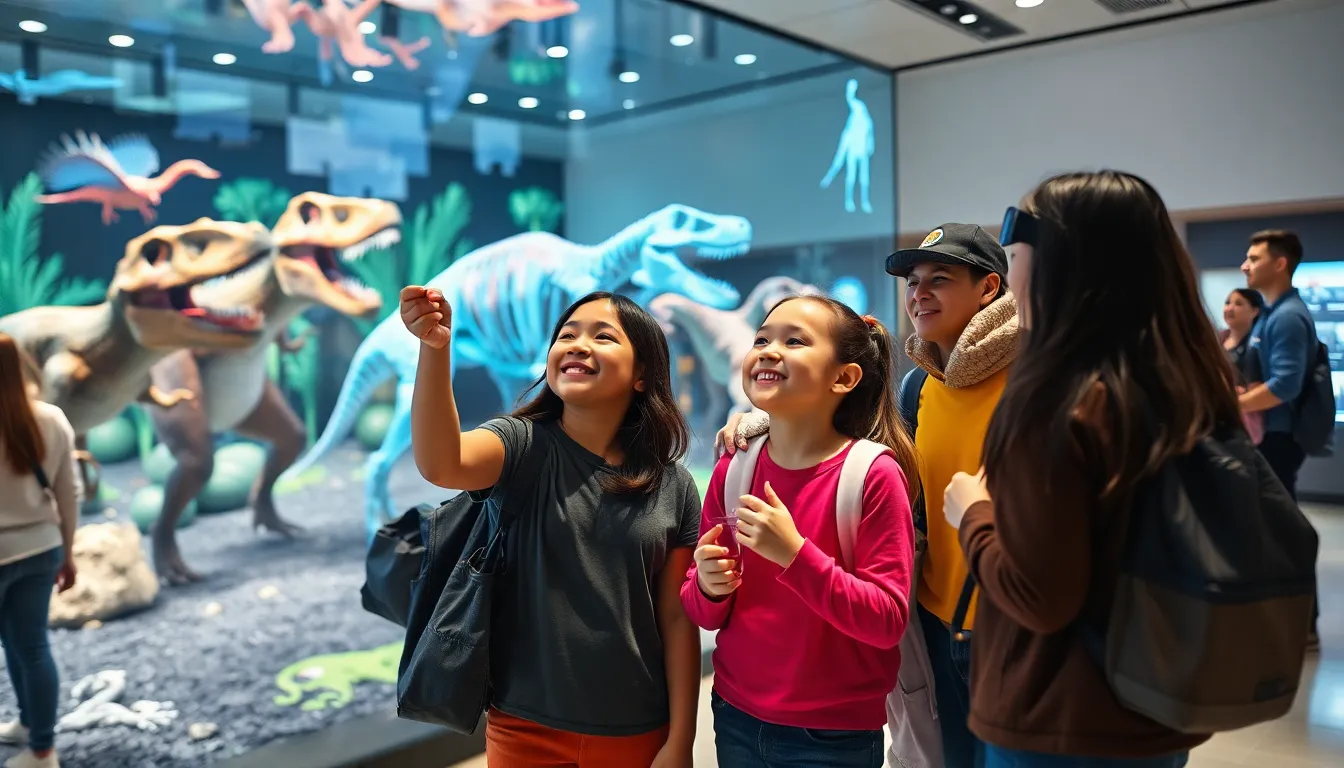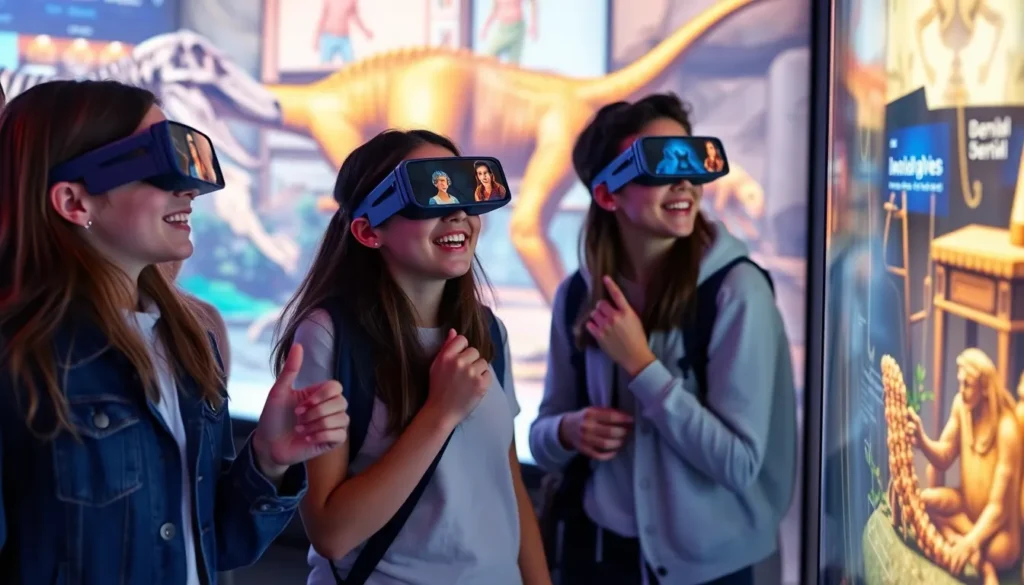Table of Contents
ToggleImagine stepping into a museum where the exhibits leap off the walls and into your imagination. Welcome to the world of augmented reality museums, where history and technology collide in the most spectacular way. Forget dusty old displays and long-winded placards; this is where art comes alive, and ancient artifacts can crack a joke or two.
What Is an Augmented Reality Museum?
An augmented reality museum blends digital elements with the physical environment. This innovative approach enhances the visitor experience by overlaying graphics, sounds, and other sensory stimuli onto real-world artifacts. Enhanced interactions encourage deeper engagement with exhibits.
Visitors can, for example, use smartphones or AR glasses to see 3D models of ancient artifacts spring to life. They might explore interactive timelines that provide historical context for displayed items. Real-time information comes alive through virtual labels and guided tours without traditional limitations.
Many museums now incorporate this technology to attract younger audiences. Using augmented reality attracts tech-savvy visitors who seek immersive experiences. Interactive installations often communicate complex ideas in an entertaining manner.
Currently, several prominent institutions worldwide embrace this technology. The Smithsonian National Museum of Natural History, for instance, features AR experiences that complement traditional displays. Other examples include the Louvre, which offers visitors tablet access to AR content enhancing their art exploration.
Benefits of augmented reality museums extend beyond engagement. These settings often provide accessibility for individuals with disabilities by offering custom experiences suited to various needs. Educational opportunities multiply, as learning becomes a more dynamic process compared to standard exhibits.
Overall, augmented reality museums represent a significant shift in how art and history are presented. They transform static displays into vibrant experiences that resonate with audiences of all ages. Through this blend of technology and art, museums redefine their role in education and engagement.
Benefits of Augmented Reality Museums

Augmented reality museums offer numerous advantages, enhancing both visitor engagement and education. These benefits reflect a significant evolution in the museum experience.
Enhanced Visitor Experience
Immersive experiences captivate audiences through AR technologies. Visitors interact with exhibits in exciting ways, rather than observing static displays. For example, virtual elements allow immersion into historical events, capturing attention more effectively than traditional methods. Users can explore detailed 3D models and animations, enriching their understanding of artifacts. This interactive environment encourages exploration and curiosity, making museum visits entertaining and memorable. Statistics indicate a higher visitor satisfaction rate in museums utilizing AR, showcasing its power to transform the experience.
Educational Opportunities
Augmented reality fosters unique educational insights. Learning becomes more engaging through interactive timelines and informative graphics that enhance understanding. AR technologies provide context that traditional displays often lack, allowing visitors to grasp complex historical narratives. As an example, students visiting AR museums often retain information better, enriching their educational experiences. Accessible features benefit diverse audiences, including those with disabilities, ensuring that more individuals can participate in the learning process. This innovative approach unlocks new possibilities in education, making museums vital centers for knowledge.
Popular Examples of Augmented Reality Museums
Several renowned museums have successfully integrated augmented reality technology, transforming visitor experiences.
The Louvre Museum
The Louvre Museum in Paris showcases AR technology to enrich its renowned art collections. Visitors can use their devices to interact with famous works like the Mona Lisa and the Venus de Milo. Detailed animations provide insights into the context and history surrounding each piece. Through AR, the museum engages visitors, allowing them to see high-resolution details not visible to the naked eye. It’s a creative approach to enhancing art appreciation. The innovative use of augmented reality attracts a broader audience, including younger generations eager for interactive experiences.
The American Museum of Natural History
The American Museum of Natural History in New York offers AR experiences that immerse guests in a world of science. Dinosaurs come to life, allowing visitors to view them alongside realistic environments and interact with fossil displays. AR applications provide context on exhibits, enhancing understanding of natural history. Each feature captures the curiosity of diverse audiences. Visitors learn through exploration, making complex scientific concepts accessible and engaging. The museum’s commitment to technology places it at the forefront of educational innovation in the cultural sector.
Challenges in Implementing Augmented Reality
Implementing augmented reality in museums presents notable challenges. First, high development costs often deter institutions from investing in the technology. Expenses linked to software creation, hardware acquisition, and ongoing maintenance accumulate quickly, limiting budgetary flexibility for many museums.
Second, technical limitations can hinder user experiences. Insufficient Wi-Fi connectivity often disrupts seamless interactions, while outdated devices may not support advanced AR applications. Each obstacle discourages visitors from fully engaging with the technology, ultimately affecting their experience.
Third, training staff poses a significant challenge. Museums require employees knowledgeable in AR technology to assist visitors effectively. Hiring and training personnel with the right expertise can increase operational costs and complicate staffing logistics.
Moreover, content creation remains a critical issue. Crafting immersive, high-quality AR content takes time and skilled resources. Many museums lack in-house capabilities, leading to reliance on external vendors, which complicates workflows and prolongs project timelines.
Audiences also present challenges. Some visitors may be hesitant to embrace new technology due to generational differences in tech-savviness. Ensuring that AR experiences appeal to diverse age groups requires careful consideration and thoughtful design.
Lastly, accessibility concerns must be addressed. While AR enhances experiences for many, it may inadvertently exclude visitors with disabilities. Implementing universal design principles is vital to ensure inclusive experiences for all, including those requiring assistive technologies.
Facing these challenges requires strategic planning and commitment. Museums that can navigate these obstacles successfully can transform their offerings, creating richer, more engaging visitor experiences in the world of augmented reality.
Future Trends in Augmented Reality Museums
Emerging technologies will redefine the experiences offered by augmented reality museums. Advanced AR apps continue to improve user interactions with exhibits. Institutions are focusing on personalized experiences, catering content to individual visitor interests. Gamification of museum visits enhances engagement, turning education into an interactive adventure.
Improvements in mobile devices and AR glasses contribute to streamlined access for wider audiences. Visitors can expect richer visuals and improved graphics quality, enhancing the realism of experiences. Interdisciplinary collaborations between museums, tech companies, and educational institutions foster innovative applications for AR technology.
Development of multisensory experiences adds another layer of immersion. Museums can utilize sound, haptic feedback, and even scent in conjunction with visual stimuli. This approach not only captivates visitors but also deepens their understanding of the material.
Augmented reality museums will increasingly adopt social sharing technologies. Visitors are encouraged to share their experiences on social media platforms, promoting museums and attracting new audiences. Data collection from these interactions offers valuable insights for improving future exhibits.
Sustainability will also play a crucial role in future AR implementations. Institutions may explore eco-friendly technologies while designing AR environments, reducing their carbon footprint. The focus on sustainability aligns with growing public interest in environmental issues.
Integration of artificial intelligence supports advanced features in AR museums. AI can personalize experiences based on visitor preferences, while also facilitating dynamic content updates. Such capabilities ensure museums remain relevant and engaging for diverse audiences.
Overall, these trends indicate a shift towards more immersive, interactive, and inclusive museum experiences.
Augmented reality museums are revolutionizing the way people engage with art and history. By blending digital elements with physical exhibits, these institutions create immersive experiences that captivate visitors and foster a deeper understanding of complex narratives.
As technology continues to advance, AR museums will likely evolve, offering even more personalized and interactive content. The potential for enhanced accessibility and educational opportunities makes this approach an essential part of the future of cultural institutions.
Museums that embrace augmented reality not only attract a younger audience but also solidify their relevance in an increasingly digital world. The journey towards fully realizing the potential of AR in museums is just beginning, promising exciting developments for visitors and institutions alike.







